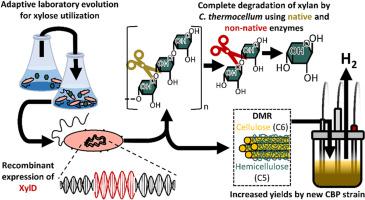当前位置:
X-MOL 学术
›
Metab. Eng.
›
论文详情
Our official English website, www.x-mol.net, welcomes your feedback! (Note: you will need to create a separate account there.)
Engineering the cellulolytic bacterium, Clostridium thermocellum, to co-utilize hemicellulose
Metabolic Engineering ( IF 6.8 ) Pub Date : 2024-04-15 , DOI: 10.1016/j.ymben.2024.03.008 Katherine J. Chou , Trevor Croft , Skyler D. Hebdon , Lauren R. Magnusson , Wei Xiong , Luis H. Reyes , Xiaowen Chen , Emily J. Miller , Danielle M. Riley , Sunnyjoy Dupuis , Kathrin A. Laramore , Lisa M. Keller , Dirk Winkelman , Pin-Ching Maness
Metabolic Engineering ( IF 6.8 ) Pub Date : 2024-04-15 , DOI: 10.1016/j.ymben.2024.03.008 Katherine J. Chou , Trevor Croft , Skyler D. Hebdon , Lauren R. Magnusson , Wei Xiong , Luis H. Reyes , Xiaowen Chen , Emily J. Miller , Danielle M. Riley , Sunnyjoy Dupuis , Kathrin A. Laramore , Lisa M. Keller , Dirk Winkelman , Pin-Ching Maness

|
Consolidated bioprocessing (CBP) of lignocellulosic biomass holds promise to realize economic production of second-generation biofuels/chemicals, and is a leading candidate for CBP due to it being one of the fastest degraders of crystalline cellulose and lignocellulosic biomass. However, CBP by is approached with co-cultures, because does not utilize hemicellulose. When compared with a single-species fermentation, the co-culture system introduces unnecessary process complexity that may compromise process robustness. In this study, we engineered to co-utilize hemicellulose without the need for co-culture. By evolving our previously engineered xylose-utilizing strain in xylose, an evolved clonal isolate (KJC19-9) was obtained and showed improved specific growth rate on xylose by ∼3-fold and displayed comparable growth to a minimally engineered strain grown on the bacteria's naturally preferred substrate, cellobiose. To enable full xylan deconstruction to xylose, we recombinantly expressed three different β-xylosidase enzymes originating from into KJC19-9 and demonstrated growth on xylan with one of the enzymes. This recombinant strain was capable of co-utilizing cellulose and xylan simultaneously, and we integrated the β-xylosidase gene into the KJC19-9 genome, creating the KJCBXint strain. The strain, KJC19-9, consumed monomeric xylose but accumulated xylobiose when grown on pretreated corn stover, whereas the final KJCBXint strain showed significantly greater deconstruction of xylan and xylobiose. This is the first reported strain capable of degrading and assimilating hemicellulose polysaccharide while retaining its cellulolytic capabilities, unlocking significant potential for CBP in advancing the bioeconomy.
中文翻译:

改造纤维素分解细菌热纤梭菌以共同利用半纤维素
木质纤维素生物质的综合生物加工(CBP)有望实现第二代生物燃料/化学品的经济生产,并且由于它是结晶纤维素和木质纤维素生物质最快的降解剂之一,因此成为 CBP 的主要候选者。然而,CBP 通过共培养来实现,因为不利用半纤维素。与单一物种发酵相比,共培养系统引入了不必要的工艺复杂性,可能会损害工艺的稳健性。在这项研究中,我们设计为共同利用半纤维素,而不需要共培养。通过在木糖中进化我们之前设计的利用木糖的菌株,获得了进化的克隆分离株(KJC19-9),其对木糖的比生长率提高了〜3倍,并且与在细菌自然生长的最低限度工程菌株的生长相当。优选的底物,纤维二糖。为了能够将木聚糖完全解构为木糖,我们重组表达了源自 KJC19-9 的三种不同的 β-木糖苷酶,并证明了其中一种酶在木聚糖上的生长。该重组菌株能够同时共同利用纤维素和木聚糖,我们将 β-木糖苷酶基因整合到 KJC19-9 基因组中,创建了 KJCBXint 菌株。该菌株 KJC19-9 消耗单体木糖,但在预处理的玉米秸秆上生长时积累木二糖,而最终的 KJCBXint 菌株显示出明显更大的木聚糖和木二糖解构。这是第一个报道的能够降解和同化半纤维素多糖,同时保留其纤维素分解能力的菌株,释放了 CBP 在推进生物经济方面的巨大潜力。
更新日期:2024-04-15
中文翻译:

改造纤维素分解细菌热纤梭菌以共同利用半纤维素
木质纤维素生物质的综合生物加工(CBP)有望实现第二代生物燃料/化学品的经济生产,并且由于它是结晶纤维素和木质纤维素生物质最快的降解剂之一,因此成为 CBP 的主要候选者。然而,CBP 通过共培养来实现,因为不利用半纤维素。与单一物种发酵相比,共培养系统引入了不必要的工艺复杂性,可能会损害工艺的稳健性。在这项研究中,我们设计为共同利用半纤维素,而不需要共培养。通过在木糖中进化我们之前设计的利用木糖的菌株,获得了进化的克隆分离株(KJC19-9),其对木糖的比生长率提高了〜3倍,并且与在细菌自然生长的最低限度工程菌株的生长相当。优选的底物,纤维二糖。为了能够将木聚糖完全解构为木糖,我们重组表达了源自 KJC19-9 的三种不同的 β-木糖苷酶,并证明了其中一种酶在木聚糖上的生长。该重组菌株能够同时共同利用纤维素和木聚糖,我们将 β-木糖苷酶基因整合到 KJC19-9 基因组中,创建了 KJCBXint 菌株。该菌株 KJC19-9 消耗单体木糖,但在预处理的玉米秸秆上生长时积累木二糖,而最终的 KJCBXint 菌株显示出明显更大的木聚糖和木二糖解构。这是第一个报道的能够降解和同化半纤维素多糖,同时保留其纤维素分解能力的菌株,释放了 CBP 在推进生物经济方面的巨大潜力。











































 京公网安备 11010802027423号
京公网安备 11010802027423号